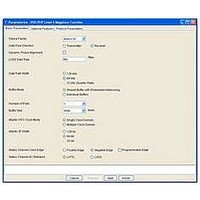IP-POSPHY4 Altera, IP-POSPHY4 Datasheet - Page 129

IP-POSPHY4
Manufacturer Part Number
IP-POSPHY4
Description
IP CORE - POS-PHY Level 4 SPI 4.2 Interface
Manufacturer
Altera
Type
MegaCorer
Datasheet
1.IP-POSPHY4.pdf
(144 pages)
Specifications of IP-POSPHY4
Software Application
IP CORE, Interface And Protocols, COMMUNICATION
Supported Families
Arria GX, Cyclone, HardCopy, Stratix
Core Architecture
FPGA
Core Sub-architecture
Arria, Cyclone, Stratix
Rohs Compliant
NA
Function
POS-PHY Level 4 Interface, Link-Layer/PHY Layer
License
Initial License
Lead Free Status / RoHS Status
na
Lead Free Status / RoHS Status
na
- Current page: 129 of 144
- Download datasheet (3Mb)
Static Alignment
Figure F–1. Static Alignment Timing Diagram
December 2010 Altera Corporation
Clock
Data 1
Data 2
Inferred
Sample Clock
The SPI-4.2 standard specifies two mechanisms for receiving data from the physical
layer: static and dynamic alignment. Both follow the same electrical specifications, but
differ in their timing requirements.
Static alignment is more traditional as it calls for a specific setup and hold time at the
receiver. The implementation in the SPI-4.2 specification is complicated by the double
data rate (DDR) clock. The actual sampling edge is implied by a synthesized clock
related to the input reference. In the specification, the receiver timing is bound by a
maximum differential between the clock and data, or frame signals. The receiver
sampling window has a fixed relationship to the input clock reference.
The timing margin for a statically-aligned system is calculated by subtracting all of
the delays from the overall period of the clock. These delays include:
■
■
■
The remaining time is allocated to the connection between parts. All of the differential
delays between traces—caused by factors such as board routing, transmission line
effects, and connector skews—consume this margin of time. Static alignment is
appropriate for areas where such factors can be well controlled. For example, the
connection between adjacent devices is generally short, and can be controlled—at
layout time—to within a few millimetres.
Figure F–1
Transmitter clock-to-data skews
Receiver sampling windows
Jitter components
shows an example of static alignment.
Receiver Sampling
Window
F. Static and Dynamic Phase Alignment
POS-PHY Level 4 MegaCore Function User Guide
Related parts for IP-POSPHY4
Image
Part Number
Description
Manufacturer
Datasheet
Request
R

Part Number:
Description:
IP CORE Renewal Of IP-POSPHY4
Manufacturer:
Altera
Datasheet:

Part Number:
Description:
IP Thermal Transfer Printer With Peel/Present Option
Manufacturer:
BRADY

Part Number:
Description:
CYCLONE II STARTER KIT EP2C20N
Manufacturer:
Altera
Datasheet:

Part Number:
Description:
CPLD, EP610 Family, ECMOS Process, 300 Gates, 16 Macro Cells, 16 Reg., 16 User I/Os, 5V Supply, 35 Speed Grade, 24DIP
Manufacturer:
Altera Corporation
Datasheet:

Part Number:
Description:
CPLD, EP610 Family, ECMOS Process, 300 Gates, 16 Macro Cells, 16 Reg., 16 User I/Os, 5V Supply, 15 Speed Grade, 24DIP
Manufacturer:
Altera Corporation
Datasheet:

Part Number:
Description:
Manufacturer:
Altera Corporation
Datasheet:

Part Number:
Description:
CPLD, EP610 Family, ECMOS Process, 300 Gates, 16 Macro Cells, 16 Reg., 16 User I/Os, 5V Supply, 30 Speed Grade, 24DIP
Manufacturer:
Altera Corporation
Datasheet:

Part Number:
Description:
High-performance, low-power erasable programmable logic devices with 8 macrocells, 10ns
Manufacturer:
Altera Corporation
Datasheet:

Part Number:
Description:
High-performance, low-power erasable programmable logic devices with 8 macrocells, 7ns
Manufacturer:
Altera Corporation
Datasheet:

Part Number:
Description:
Classic EPLD
Manufacturer:
Altera Corporation
Datasheet:

Part Number:
Description:
High-performance, low-power erasable programmable logic devices with 8 macrocells, 10ns
Manufacturer:
Altera Corporation
Datasheet:

Part Number:
Description:
Manufacturer:
Altera Corporation
Datasheet:

Part Number:
Description:
Manufacturer:
Altera Corporation
Datasheet:











